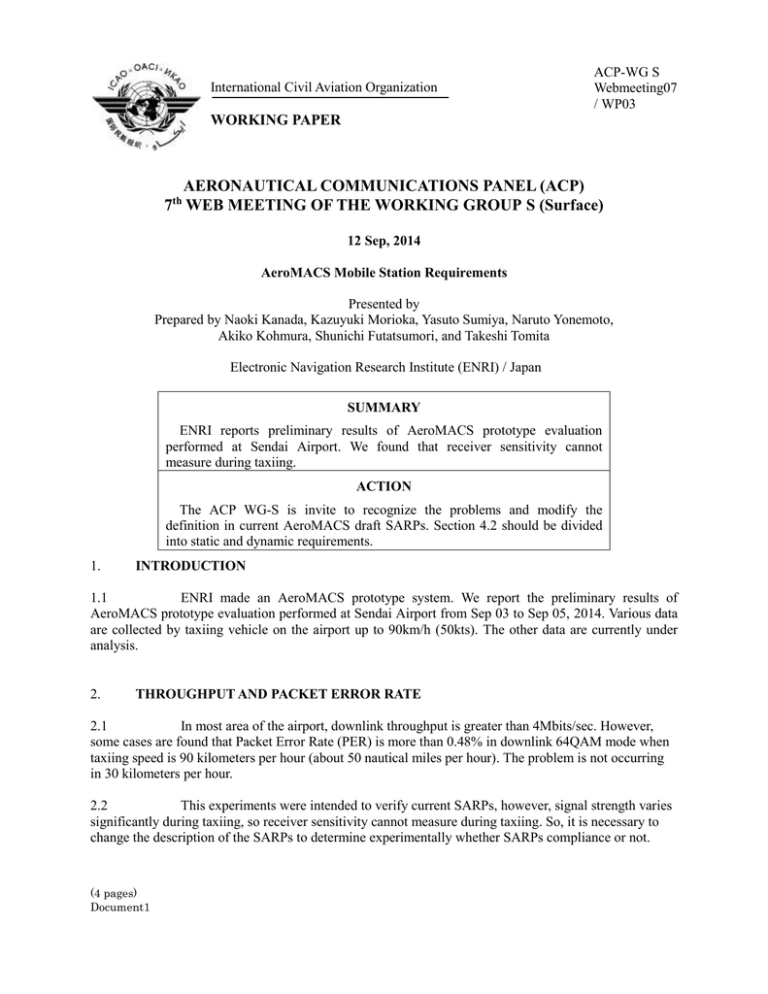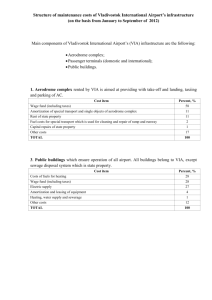AeroMACS_Prototype preliminary evaluation report by ENRI
advertisement

International Civil Aviation Organization ACP-WG S Webmeeting07 / WP03 WORKING PAPER AERONAUTICAL COMMUNICATIONS PANEL (ACP) 7th WEB MEETING OF THE WORKING GROUP S (Surface) 12 Sep, 2014 AeroMACS Mobile Station Requirements Presented by Prepared by Naoki Kanada, Kazuyuki Morioka, Yasuto Sumiya, Naruto Yonemoto, Akiko Kohmura, Shunichi Futatsumori, and Takeshi Tomita Electronic Navigation Research Institute (ENRI) / Japan SUMMARY ENRI reports preliminary results of AeroMACS prototype evaluation performed at Sendai Airport. We found that receiver sensitivity cannot measure during taxiing. ACTION The ACP WG-S is invite to recognize the problems and modify the definition in current AeroMACS draft SARPs. Section 4.2 should be divided into static and dynamic requirements. 1. INTRODUCTION 1.1 ENRI made an AeroMACS prototype system. We report the preliminary results of AeroMACS prototype evaluation performed at Sendai Airport from Sep 03 to Sep 05, 2014. Various data are collected by taxiing vehicle on the airport up to 90km/h (50kts). The other data are currently under analysis. 2. THROUGHPUT AND PACKET ERROR RATE 2.1 In most area of the airport, downlink throughput is greater than 4Mbits/sec. However, some cases are found that Packet Error Rate (PER) is more than 0.48% in downlink 64QAM mode when taxiing speed is 90 kilometers per hour (about 50 nautical miles per hour). The problem is not occurring in 30 kilometers per hour. 2.2 This experiments were intended to verify current SARPs, however, signal strength varies significantly during taxiing, so receiver sensitivity cannot measure during taxiing. So, it is necessary to change the description of the SARPs to determine experimentally whether SARPs compliance or not. (4 pages) Document1 ACP-WGS Webmeeting07 / WP03 -2- 3. ACTION BY THE MEETING 3.1 ACP WG-S is invited to recognize the issues and modify the definition in current AeroMACS draft SARPs. 3.2 Section 4.2 requires all of the section 3 when operating with any Doppler velocity up to 50 nautical miles per hour. However, we found that receiver sensitivity cannot measure during taxiing. Therefore, 4.2.1 should be described as separate items of static requirements and requirements during taxiing. 4. REFERENCES [1] ICAO: “Draft AeroMACS SARPs”, ICAO ACP WGS Webmeeting3 WP01, March 2014 [2] IEEE 802.16-2009 “IEEE Standard for Local and metropolitan area networks Part 16: Air Interface for Broadband Wireless Access Systems,” May 2009 [3] J. M. Budinger and E. Hall, “Aeronautical Mobile Airport Communications System (AeroMACS),” National Aeronautics and Space Administration, Glenn Research Center, 2011. [4] Kanada et. al, “Signal evaluation on airport surface in 5.1Ghz band”, Integrated Communications, Navigation and Surveillance Conference (ICNS), Herndon, VA, April 22-25, 2013. [5] Morioka et.al, “Experiments of VoIP using WiMAX System and Fading Simulator with Two-Path Models for Aeronautical Scenarios”, Integrated Communications, Navigation and Surveillance Conference (ICNS), Herndon, VA, April 8-10, 2014 ***END*** -3- ACP-WGS Webmeeting07 / WP03 ATTACHMENT: AEROMACS PROTOTYPE EVALUATION SYSTEM 1. EXPERIMENTAL SETUP 1.1 ENRI AeroMACS prototype system consists of Mobile Stations (MS), Base Stations (BS), and a back-hole system. It works in 5091-5150 MHz and bandwidth of the system is 5MHz. The system is based on current ICAO draft SRAPs. Figure 1 shows AeroMACS evaluation system overview, and Figure 2 illustrates AeroMACS evaluation system setup. The BSs and the back-hole system are installed in ENRI Iwanuma brunch nearby Sendai Airport. The back-hole system includes an Access Service Network Gateway, Home Agent server, Authentication Authorization Accounting server, Base Station Operation and Maintenance Center server, and a layer 3 switch. Figure 1. AeroMACS evaluation system overview ACP-WGS Webmeeting07 / WP03 -4- Figure 2. AeroMACS evaluation system setup 1.2 Figure 3 shows BS antennas installation. 2 antennas on the tower of 30m high are connected to a BS. The BS has 2 antenna ports. Output powers of each port are 200mW. The gains of the antennas are 11dBi. The antennas are horizontally Omni-directional. The antennas are arranged to be parallel with the runway 12/30 of Sendai Airport. Figure 3. Base Station antenna configuration






